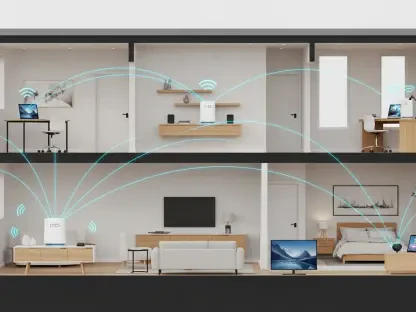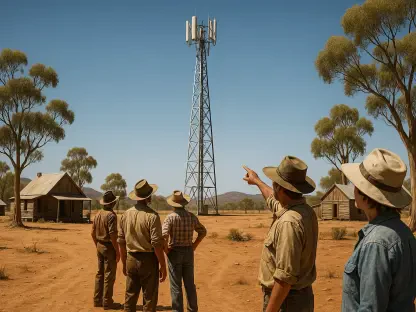Brendan Carr, the new Federal Communications Commission (FCC) Chair, has embarked on a comprehensive agenda to enhance the agency’s effectiveness and address paramount issues in the telecommunications sector. Spearheading efforts to reform spectrum allocation while reinforcing national security and consumer protection, Carr is also seeking legislative backing to ensure the FCC continues to serve the best interests of the public and industry stakeholders alike.
Accelerating Spectrum Auctioning and Reallocation
AWS-3 Licenses and National Security
One of Carr’s top priorities is the re-auctioning of the FCC’s existing AWS-3 licenses, as mandated by the National Defense Authorization Act (NDAA) of 2021. The revenues generated from this auction will significantly finance the “rip and replace” program, aimed at expelling banned Chinese telecommunications equipment from U.S. networks. The focus here is not merely on raising funds but on safeguarding U.S. telecommunication infrastructure by replacing potentially risky foreign technology, specifically targeting gear from companies like Huawei and ZTE. Carr emphasizes that introducing new spectrum for commercial use and eliminating untrustworthy technology are dual benefits that reinforce U.S. national security and foster market competition.
Carr’s approach to the AWS-3 licenses also fits into a broader strategy of maximizing the utility of available spectrum. As the demand for wireless services continues to grow exponentially, it remains imperative to ensure that U.S. telecommunications infrastructure is both robust against security threats and capable of meeting economic challenges. This initiative seeks to create a balanced environment where technological advancement is encouraged without compromising the security of the nation’s critical communications networks. The importance of national security is persistently echoed in Carr’s plans, highlighting the ongoing interlinkage between defense strategies and the need to innovate constantly in the technological space.
Upper C-Band Spectrum Utilization
Carr recently announced that the FCC would soon vote on the proposal to explore using the upper C-Band spectrum, specifically between 3.98-4.2 GHz, for more intensive commercial purposes. This initiative follows the successful auctioning of the lower C-Band spectrum, which was allocated for terrestrial mobile network use. The push for utilizing the upper C-Band is part of a larger effort to meet rising consumer demands, boost 5G services, and ensure that the U.S. remains a global leader in wireless technology. Integrating this spectrum into commercial use aligns with long-term goals of innovation and maintaining competitive edge in a rapidly evolving digital landscape.
By repurposing the upper C-Band spectrum, the FCC aims to further support the expansion and enhancement of 5G networks, which are pivotal for the Internet of Things (IoT) and next-generation applications. The utility of this spectrum underscores how crucial it is for the U.S. to stay ahead of technological trends, ensuring that mobile carriers can provide faster, more reliable services. This strategy is also consistent with the broader agenda of reassessing and reallocating spectrum to maximize efficiency and innovation, a persistent theme in Carr’s vision for the FCC. In an era where mobile connectivity touches every aspect of daily life, the utilization of the upper C-Band marks a forward-thinking approach to sustaining technological leadership.
Industry Support and Stakeholder Perspectives
Positive Feedback from Industry Stakeholders
The proposal to open the upper C-Band spectrum has already garnered significant positive feedback from industry stakeholders, affirming its pivotal nature in the telecommunications sector. Notably, the CTIA, which represents the wireless communications industry, has warmly welcomed the initiative, highlighting the essential role licensed spectrum plays in fortifying America’s wireless networks. The CTIA underscores that increased spectrum availability is directly tied to driving innovation, creating jobs, and maintaining economic competitiveness. Their enthusiasm reflects a broader consensus within the industry, indicating that Carr’s proposal aligns well with stakeholder expectations and needs.
Outgoing CTIA President and CEO Meredith Attwell Baker expressed optimism in working closely with the FCC to realize these ambitious goals. Baker’s sentiment illustrates a prevalent industry viewpoint that collaborative efforts between regulatory bodies and industry players are essential for the successful implementation of spectrum-related initiatives. The alignment between Carr’s plans and industry support signals a positive environment for policy implementation, which is crucial for ensuring that the U.S. telecommunications infrastructure remains resilient and technologically advanced. Stakeholder endorsement is often a bellwether for the initiative’s potential to drive meaningful progress in the sector.
Collaboration with Telecommunications Industry
Carr’s vision has also been endorsed by various telecommunications companies and industry groups who see increased spectrum availability as a pathway to improved network performance and enhanced consumer experiences. The collaboration between the FCC and the telecommunications industry is vital for the successful implementation of Carr’s initiatives, as it brings together regulatory oversight and industry expertise. This concerted effort ensures that spectrum policies are effectively translated into practice, fostering an environment where technological advancements can thrive without significant regulatory impediments.
Telecommunication companies are particularly interested in the potential benefits of additional spectrum, which include better network capacity, reduced latency, and greater service reliability. The industry’s active involvement in supporting these initiatives illustrates the mutual interest in advancing telecommunications capabilities while observing regulatory compliance. These partnerships are critical in realizing the vision of a more capable, secure, and innovative U.S. telecom sector. Carr’s strategy emphasizes this collaborative framework, reflecting how regulatory measures can be harmonized with industry objectives to achieve comprehensive progress.
Addressing Robocalls and Enhancing Emergency Alerts
Expanding Do-Not-Originate Lists
Robocalls have long been a thorn in the side of consumers, defrauding individuals and degrading trust in telecommunications services. To address this ongoing issue, Carr’s leadership will prioritize expanding Do-Not-Originate lists, an important measure that prevents fraudulent call origination. The FCC plans to vote on this expansion, aiming to enhance call-blocking technologies further and safeguard consumers from unwanted and potentially harmful communications. This is part of a broader commitment by the FCC to not only advance technology but also protect the end-users from the malfeasance that technology can enable.
Expanding these lists will involve closer coordination with telecommunications providers and enhancing the technological capabilities used to detect and block these calls. The effectiveness of call-blocking mechanisms hinges on the ability to adapt to evolving tactics employed by those who perpetuate these fraudulent schemes. Carr’s focus on expanding the Do-Not-Originate lists is integral to building a more secure telecommunications environment. As part of this initiative, the FCC will also consider additional regulatory measures and collaborative frameworks with service providers to ensure these efforts yield substantial results.
Improving Mobile Emergency Alerts
The FCC under Carr’s leadership is also set to enhance the effectiveness of mobile emergency alerts, a critical communication tool during disasters and crises. Carr plans to increase flexibility for emergency managers, allowing them to send more targeted and timely alerts to the public. This initiative represents a significant step in balancing the need for technological advancement with consumer protection and safety. Carr’s commitment to this cause underscores the importance of reliable, quick communication during emergencies, where every second saved can translate into lives saved.
Enhancing the flexibility and targeting of mobile emergency alerts involves upgrading the existing infrastructure and providing more sophisticated tools to emergency managers. This means leveraging advancements in technology to ensure that alerts are not only timely but also reach the right audience without causing unnecessary panic. This initiative is aligned with Carr’s broader agenda of ensuring that the telecommunications framework in the U.S. supports public safety in addition to promoting innovation and connectivity. By improving emergency alert systems, the FCC is setting a precedent for leveraging technology for the public good, reinforcing the role of telecommunications in community safety.
Legislative Actions and Auction Authority
Spectrum Pipeline Act of 2025
Legislative support is pivotal for the FCC to continue its mission, and the introduction of the Spectrum Pipeline Act of 2025 in the U.S. House of Representatives is a key step in that direction. This proposed bill, which mirrors its Senate counterpart, requires the National Telecommunications and Information Administration (NTIA) to identify at least 2,500 megahertz of midband spectrum for reallocation or sharing over the next five years. It also mandates that the FCC auction off 1,250 megahertz for full-power commercial wireless services within the next six years. This legislative action provides a clear framework to ensure that the U.S. spectrum resources are allocated efficiently and in a way that supports technological growth.
The Spectrum Pipeline Act is designed to provide long-term sustainability for the FCC’s auction authority, which expired in early 2023. By legislating specific spectrum reallocation targets, the Act promotes a proactive approach to spectrum management, ensuring that the FCC can keep pace with technological advancements and industry requirements. Congressional support for this bill underscores a broader recognition of the critical role the FCC plays in managing the nation’s spectrum resources. As technological demands evolve, so too must the strategies and policies guiding spectrum allocation and utilization.
Sustaining FCC’s Auction Authority
The legislative measures outlined in the Spectrum Pipeline Act of 2025 are designed not only to extend the FCC’s auction authority but also to address the broader issue of sustaining its capacity for effective spectrum management. These actions ensure that the FCC can continue to fulfill its mandate efficiently, balancing the demands of national security, technological innovation, and consumer protection. Legislative backing is essential for the FCC to maintain and enhance its role, making it a continuous partner in the nation’s technological progress.
The support from Congress is pivotal in sustaining and reinforcing the regulatory framework that empowers the FCC. With provisions to auction and reallocate critical spectrum bands, the legislative actions bolster the FCC’s position as a central authority in telecommunications regulation. Sustaining auction authority through legislative means ensures that the FCC remains agile and responsive to industry needs, reflecting a balanced approach between regulatory oversight and market demands. The collaboration between the FCC and Congress is thus a testament to the integral role of legislative foresight in the governance of telecommunications infrastructure.
Envisioning a Progressive Future
Brendan Carr, the new Chair of the Federal Communications Commission (FCC), is implementing a wide-ranging agenda to bolster the agency’s performance and tackle crucial issues in the telecom sector. Carr is pioneering efforts to reform the allocation of spectrum resources, which are essential for wireless communications, while simultaneously strengthening national security and boosting consumer protections. He understands the importance of balancing technological advancement with public safety. Furthermore, Carr is actively pursuing legislative support to guarantee that the FCC can effectively serve the public and meet the needs of industry stakeholders. His vision is to ensure that the FCC remains a competent regulatory body that can adapt to the rapid changes in technology and communication methods. By fostering collaboration between the government, private sector, and consumers, Carr aims to foster an environment where innovation can thrive while maintaining stringent protection and security standards.









